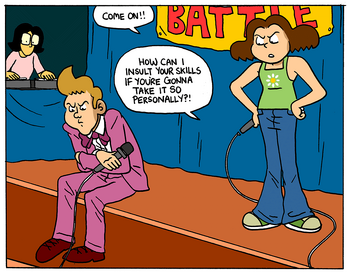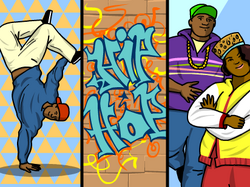| Hip-Hop and Rap | |||
|---|---|---|---|
| Airdate | March 5, 2011
Update: October 19, 2023 | ||
| Curriculum | Social Studies Arts & Music | ||
Hip-Hop and Rap launched in BrainPOP Social Studies/Arts & Music March 5, 2011.
Plot[]
Tim is reading a book and Moby brings in a robot. Tim says he hopes it's not another Jazz-bot. He says the last one played a trumpet solo that went on for six months. When the robot raps, he finds out it's a Rap-bot. Tim mentions a introduction about hip-hop and rap. Tim includes things like DJs, scratching records and breakdancing. He asks the Rap-bot what it's favorite rapper is. The Rap-bot holds up a CD with Kenny G on it. Tim yells "This isn't a Rap-bot at all! It's a Jazz-bot in disguise!" and he covers his ears when, yet again, Jazz-bot strikes!
Appearances[]
- Tim
- Moby
- Rap-bot
- Kenny G (mentioned and only seen in album cover)
- Jazz-bot (secretly Rap-bot in disguise)
- Nat (remake)
Transcript[]
Quiz[]
Quotes[]
2011-2023[]
- Rap-bot:
- Tim: [as Rap Bot spray paints the microwave]
- [last lines]
- Tim: So Rap Bot I'm Curious Who's Your Favorite Rapper?
- Rap-Bot: [holds up a Kenny G cover]
- Tim: Kenny G? Wait a sec. He's not a--- not a rapper! He's a... But that's jazz, this isn't a rap bot at all, it's a jazz bot in disguise. Oh, man, you created a monster. [Moby beeps, Tim covers his ears and frowns] Make it stop!
Updated version[]
- [last lines]
References[]
- I'll Be Missing You - Puff Daddy / Every Breath You Take - The Police
- Rapper's Delight - The Sugar Hill Gang (debuted in 1979)
Related readings[]
Language

Beef: An argument or disagreement
Benjamins: $100 bills, because they have Benjamin Franklin’s picture on them
Blow it up: Give a great performance that drives an audience wild
Crunk: A style of hip-hop from the South; also means “crazy” or “wild”
Drop science: Teach something important
Flow: The way an MC delivers rhymes; a great rapper has a smooth flow
Freestyle: An improvised rap, in which an MC delivers rhymes without writing them down beforehand
Front: To pretend to be something you’re not
Human beatbox: Someone who creates beats with his mouth and body, instead of drum machines or turntables
Hype man: A sidekick who works with a rapper to keep the crowd excited
Loop: A fragment of a recording that is repeated over and over to form the backing track of a song
Old-school: Often refers to hip-hop from the 1980s
Peeps: Short for “people,” refers to a person’s friends or crew
Serve: To beat someone in a rap or dance battle
Tag: To write one’s name, graffiti-style
Way Back When

Rap didn’t spring up out of nowhere—in fact, its roots go back centuries. Here’s a quick look at some precursors to rap.
Call-and-Response: The MCs at 1970s block parties would often engage in call-and-response with the crowd—for example, they’d call out, “Everybody say YEAH,” and the crowd would respond by shouting, “YEAH!” This has its roots in the call-and-response structure of blues songs, and the give-and-take between African-American preachers and their congregations.
The Last Poets and Gil Scott-Heron: These performers, active in the late 1960s and early 1970s, delivered socially conscious, spoken-word lyrics over rhythmic beats.
The Dozens: Similar to the rap battles which became popular in the 1980s, “the dozens” is an old game, popular in African-American communities, in which two speakers face off and see who can come up with the cleverest insults. If you’ve ever told a “your mama” joke, you’ve played a version of the dozens.
Rudy Ray Moore and Muhammad Ali: Humor has always been a part of rap—and so has bragging. During the 1960s and 70s, comedian and actor Rudy Ray Moore became famous for his humorous, rhyming boasts, while boxer Muhammad Ali (pictured) also delivered funny poems that exaggerated his skills and put down his opponents (“I murdered a rock, hospitalized a brick . . . I’m so mean I make medicine sick!”).
Dub Reggae: In Jamaica, large, outdoor parties—similar to New York block parties—featured DJs with huge sound systems spinning reggae records. Often, these DJs “toasted,” or spoke rhythmically, over “dub” versions of songs. “Dub” versions were special remixes of songs with the lyrics removed and the drum and bass parts emphasized. DJ Kool Herc, one of the earliest Bronx DJs, was a native of Jamaica.
Arts and Entertainment

In the early 1980s, graffiti was viewed as nothing but vandalism—a crime and a public nuisance. But today, it’s also considered an important urban art form.
Although graffiti has existed for thousands of years, its modern incarnation is often traced to a young New York messenger, who marked, or “tagged,” his name wherever he traveled. Soon the words “TAKI 183” appeared throughout New York City. (“Taki” was the messenger’s nickname, and “183” referred to his address on 183rd St.)
In 1971, the New York Times ran an article on Taki 183, and soon, artistically inclined young people began “tagging” as well. Graffiti style evolved, and nicknames were written in increasingly complicated, colorful lettering styles. The biggest, boldest, most noticeable tags were done in spray-paint.
Taggers wanted their creations seen by as many people as possible. In fact, they’d compete with each other to see who could tag the most visible locations and create the most interesting, artistic designs.
The best way to show one’s art to the maximum number of people involved painting it on subway trains, which traveled across the entire city. Crews of artists also painted enormous “throw-ups”—huge murals painted on walls, handball courts, and other large public spaces.
By the late 1970s, graffiti was being recognized as an art form, and graffiti artists were displaying their works in art galleries. During the 1980s, graffiti artists Keith Haring and Jean-Michel Basquiat became art-world celebrities. And today, the work of street artists like Banksy and Shepherd Fairey is recognized around the world.
Quirky Stuff

Here’s a look at how some famous rappers got their names.
LL Cool J: Short for “Ladies Love Cool James”
Da Brat: A reference to her being a “spoiled only child”
Foxy Brown: Named after a 1974 action movie starring Pam Grier
50 Cent: A metaphor for “change,” and a reference to a famous Brooklyn criminal from the 1980s
Run-DMC: Combines the names of the group’s two MCs, Joseph “Run” Simmons and Darryl “DMC” McDaniels
Queen Latifah: From a childhood nickname, Latifah, meaning “delicate” and “kind” in Arabic
Beastie Boys: Taken from a phrase in a book based on The Fog, a 1981 horror movie
Jay-Z: Combines references to his childhood nickname, “Jazzy,” his musical mentor, Jaz-O, and the J and Z subway lines which stopped near his Brooklyn home
M.I.A.:A combination of a military term meaning “Missing in Action” and her given first name, Maya
Sean “Diddy” Combs: Originally known as “Puff Daddy,” because of the way he “huffed and puffed” when he got angry as a child
Eminem: Marshall Mathers named himself after his initials, “MM”
Snoop Dogg: After his childhood nickname; his parents called him “Snoopy” because he reminded them of the famous cartoon dog
Famous Faces

From the beginning, male artists have tended to dominate hip-hop culture. Nevertheless, a number of women have found success as rappers. Here are some of them.
In 1988, New Yorker MC Lyte became the first solo female rapper to release a full-length album. She was also the first female MC to have a single hit #1 on the Billboard rap chart, and the first rapper—male or female—to play Carnegie Hall. Notably, she participated in the Stop the Violence Movement founded by rapper KRS-One, which sought to halt violent activity in African-American neighborhoods.
Lyte’s success was built upon by New Jersey’s Queen Latifah, who released the hit album All Hail the Queen in 1989. Its biggest single was “Ladies First,” a duet about female empowerment featuring fellow female MC Monie Love. Latifah followed up in 1994 with another feminist anthem, “U.N.I.T.Y.,” before embarking on a successful career as a singer and actress.
New Yorkers Salt-n-Pepa, whose lineup features two female MCs and a female DJ, burst on the scene in 1987, and have since sold more than 15 million singles and albums worldwide. Equally successful was Virginia native Missy Elliott whose 2002 album, Under Construction, spawned a massive hit called “Work It.” Elliott has used her fame to combat domestic violence and childhood obesity.
Few MCs have risen to the heights achieved by New Jersey’s Lauryn Hill. At first, she belonged to a group called the Fugees, whose 1996 release, The Score, sold millions of copies and won two Grammy Awards. Her solo follow-up, 1998’s The Miseducation of Lauryn Hill, also sold millions and won five Grammys. The artist took the next decade off to concentrate on her family, but returned to performing in the early 2010s.
Clockwise from top left: MC Lyte, Queen Latifah, Salt-n-Pepa, Lauryn Hill, Missy Elliott
Laws and Customs

Hip-hop artists frequently sample, or borrow, bass lines, drum parts, and other instrumental elements from older recordings. Usually, this is done with a synthesizer-like device called a digital sampler. Funky records from the 1970s have always been popular sources of samples, and some songs by soul legends James Brown and George Clinton have been sampled literally hundreds of times.
To comply with copyright law, rappers (or their record companies) must “clear” samples by obtaining the original artists’ permission, and then paying them. When samples are cleared before a song or album is released, everyone’s happy. The original artist gets paid, and the rapper (hopefully) gets a new hit.
In fact, many artists enjoy having their work sampled, since it introduces their old songs to new audiences. Many—including Stevie Wonder, Sting, and Led Zeppelin guitarist Jimmy Page—have even performed onstage with rappers who’ve sampled them.
But when samples aren’t cleared, things can get dicey. If the copyright holder of a sampled work isn’t paid, he or she can sue and prevent the new song from being sold in stores or played on the radio. This can happen even if a sample is just a few seconds long!
Sampling controversies have existed since the dawn of rap music. In fact, the creators of “Rapper’s Delight,” the very first hit hip-hop record, were threatened with legal action for borrowing elements of a disco song called “Good Times” by Chic.
Sampling isn’t limited to rap. In one of the most notorious copyright cases of all time, a British rock group called The Verve was forced to surrender all the royalties from their 1997 hit “Bittersweet Symphony,” because it borrowed elements from an orchestral version of a Rolling Stones song.
FYI Comics[]


